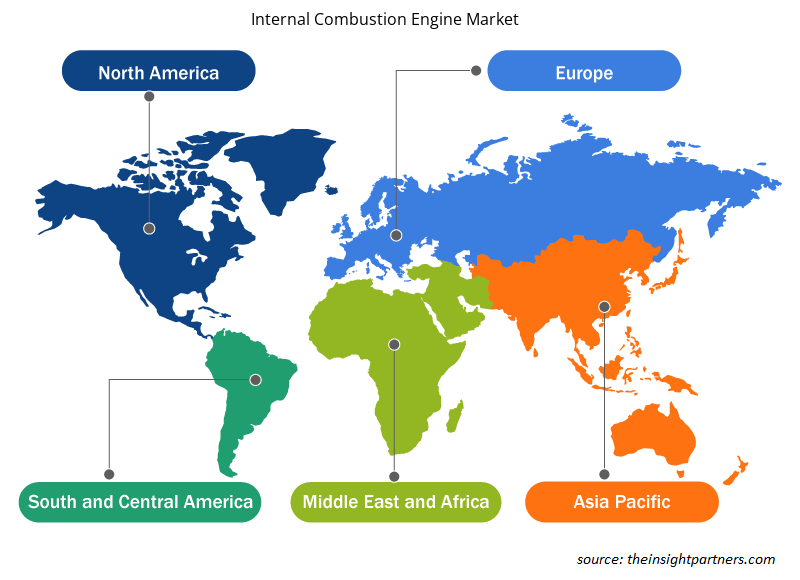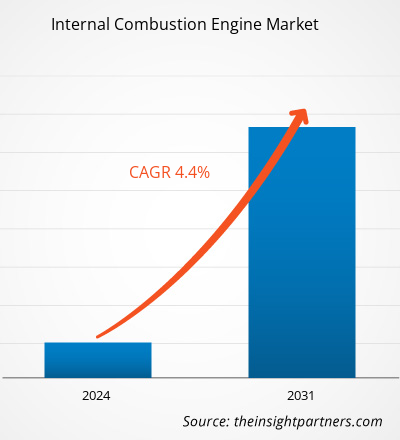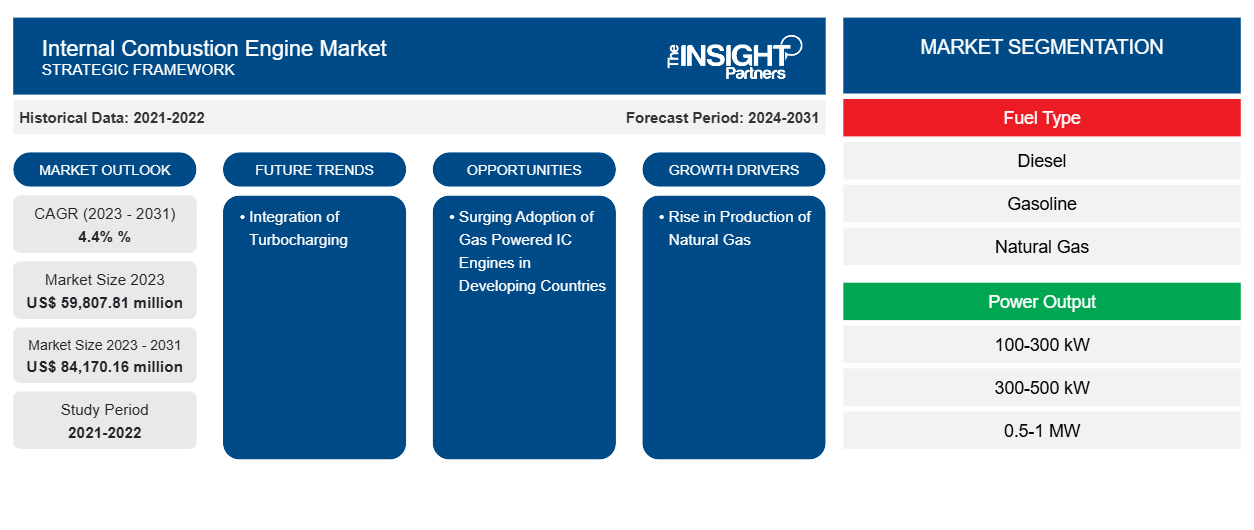من المتوقع أن يصل حجم سوق محركات الاحتراق الداخلي إلى 84,170.16 مليون دولار أمريكي بحلول عام 2031 من 59,807.81 مليون دولار أمريكي في عام 2023. ومن المتوقع أن يسجل السوق معدل نمو سنوي مركب بنسبة 4.4٪ في الفترة 2023-2031. ومن المرجح أن يظل قبول الغاز الطبيعي لتوليد الطاقة في القطاعات الصناعية والتجارية من الاتجاهات الرئيسية لسوق محركات الاحتراق الداخلي.CAGR of 4.4% % in 2023–2031. The fueling acceptance of natural gas for power generation in, industrial, and commercial sectors is likely to remain key internal combustion engine market trends.
تحليل سوق محركات الاحتراق الداخلي
إن الطلب المتزايد على المحركات التي تعمل بالغاز الطبيعي في التطبيقات في الصناعات الثقيلة مثل المعادن ومعالجة الأغذية والمواد الكيميائية يدفع السوق بشكل كبير. علاوة على ذلك، فإن المخاوف المتزايدة بشأن الانبعاثات وتحسين المعايير التنظيمية تساعد في نمو السوق في قطاع السيارات. في سوق محركات الاحتراق الداخلي، تعد صناعات السيارات والنفط والغاز المتوسطة والصناعات النائية والثقيلة والتصنيع الخفيف والمرافق والطرق الوعرة ومراكز البيانات وMUSH والتجارية من المستخدمين النهائيين.datacenters, MUSH, and commercial are end users.
نظرة عامة على سوق محركات الاحتراق الداخلي
إن ظاهرة الاحتباس الحراري العالمي المتزايدة تشكل مصدر قلق بيئي كبير في جميع أنحاء العالم. وتفرض حكومات مختلف الدول قيودًا معينة للسيطرة على انبعاثات محركات الديزل والبنزين ؛ وبالتالي، فإن التركيز المتزايد على البدائل الصديقة للبيئة يجبر مصنعي المحركات على تطوير تقنيات لجعل محركات الاحتراق الداخلي أكثر فعالية وإنتاج انبعاثات أقل. ويحول المصنعون والعملاء الآن انتباههم نحو تطبيق الوقود البديل في محركات الاحتراق الداخلي. على سبيل المثال، تنبعث من محركات الاحتراق الداخلي التي تعمل بالغاز الطبيعي انبعاثات أقل لإنتاج الكمية اللازمة من الطاقة بكفاءة عالية. وتفرض هيئات مراقبة الانبعاثات والتنظيم من مختلف الدول لوائح صارمة على استخدام محركات الديزل والمولدات. وللوفاء بهذه المعايير التنظيمية، تقوم العديد من الصناعات بتنفيذ محركات ومولدات الغاز لتوليد الطاقة.
قم بتخصيص هذا التقرير ليناسب متطلباتك
ستحصل على تخصيص لأي تقرير - مجانًا - بما في ذلك أجزاء من هذا التقرير، أو تحليل على مستوى الدولة، وحزمة بيانات Excel، بالإضافة إلى الاستفادة من العروض والخصومات الرائعة للشركات الناشئة والجامعات
- احصل على أهم اتجاهات السوق الرئيسية لهذا التقرير.ستتضمن هذه العينة المجانية تحليلاً للبيانات، بدءًا من اتجاهات السوق وحتى التقديرات والتوقعات.
محركات الاحتراق الداخلي والعوامل المحفزة والفرص المتاحة في السوق
ارتفاع إنتاج الغاز الطبيعي لصالح سوق محركات الاحتراق الداخلي
يتزايد الطلب على محركات الغاز في قطاع توليد الطاقة مع سياسات التحكم الجديدة في الانبعاثات. القطاع الصناعي، بما في ذلك المعادن والمواد الكيميائية والصناعات التحويلية، هو مساهم رئيسي في الطلب المتزايد على محركات الغاز. إن توليد الغاز الطبيعي، وهو أحد أنواع الوقود المطلوبة لمحركات الاحتراق الداخلي، ينمو بمعدل كبير. القطاع الصناعي، بما في ذلك المعادن والمواد الكيميائية والصناعات التحويلية، هو مساهم رئيسي في الطلب المتزايد على محركات الاحتراق الداخلي. إن توليد الغاز الطبيعي، وهو ضروري لتشغيل محركات الاحتراق الداخلي، يرتفع بمعدل كبير. تعمل التطبيقات الرئيسية مثل توليد الكهرباء والتدفئة وتشغيل المركبات على تعزيز متطلبات محركات الاحتراق الداخلي التي تعمل بالغاز الطبيعي. وبالتالي، لتقديم حل لانقطاع التيار الكهربائي المفاجئ، تستخدم شركات خدمات المرافق مولدات الغاز لإدارة الأحمال القصوى. وبالتالي، فإن الارتفاع المستمر في الطلب من البلدان النامية هو أحد العوامل الرئيسية التي تدفع نمو سوق محركات الاحتراق الداخلي.
تزايد استخدام محركات الغاز في الدول النامية – فرصة في سوق محركات الغاز
إن الزيادة في عدد السكان والافتقار إلى البنية الأساسية الداعمة للتكنولوجيات الكهربائية هي العوامل الرئيسية التي تدعم سوق محركات الاحتراق الداخلي. إن الأجهزة الكهربائية والمحركات الكهربائية ومحطات الطاقة الشمسية ومشاريع طاقة الرياح أكثر تكلفة من محركات الغاز، مما يفرض تفضيل العديد من الدول لمحركات الغاز كبديل صديق للبيئة. علاوة على ذلك، فإن التطورات في معايير الانبعاثات لمحركات الديزل التي تتحول من خلالها العديد من الصناعات النهائية إلى محركات الغاز لانخفاض الانبعاثات. تميل الدول الناشئة بشكل فعال نحو اعتماد الغاز الطبيعي لتوليد الطاقة. وبالتالي، من المتوقع أن توفر الشعبية المتزايدة للغاز الطبيعي فرصًا مربحة لسوق محركات الاحتراق الداخلي.
تقرير تحليل تجزئة سوق محرك الاحتراق الداخلي
إن القطاعات الرئيسية التي ساهمت في اشتقاق تحليل سوق محرك الاحتراق الداخلي هي نوع الوقود، وناتج الطاقة، والمستخدم النهائي.
- بناءً على نوع الوقود، تم تقسيم سوق محركات الاحتراق الداخلي إلى ديزل وبنزين وغاز طبيعي. احتل قطاع البنزين حصة سوقية أكبر في عام 2023.
- من حيث إنتاج الطاقة، تم تقسيم السوق إلى 100-300 كيلو وات، و300-500 كيلو وات، و0.5-1 ميجا وات، و1-5 ميجا وات، و5-15 ميجا وات، و15-25 ميجا وات، و25 ميجا وات وما فوق. وقد هيمنت شريحة 100-300 كيلو وات على السوق في عام 2023.
- من حيث المستخدم النهائي، تم تقسيم السوق إلى قطاعات صناعية وبحرية وتوليد الطاقة والفضاء والدفاع والسيارات والطرق الوعرة وغيرها. هيمن قطاع السيارات على السوق في عام 2023.
- من حيث الأسطوانات، تم تقسيم السوق إلى 1 و2 و3 و4. سيطر قطاع الأسطوانات الأربع على السوق في عام 2023.
تحليل حصة سوق محركات الاحتراق الداخلي حسب المنطقة الجغرافية
ينقسم النطاق الجغرافي لتقرير سوق محرك الاحتراق الداخلي بشكل أساسي إلى خمس مناطق: أمريكا الشمالية، ومنطقة آسيا والمحيط الهادئ، وأوروبا، والشرق الأوسط وأفريقيا، وأمريكا الجنوبية/أمريكا الجنوبية والوسطى.
تنقسم سوق محركات الاحتراق الداخلي في منطقة آسيا والمحيط الهادئ إلى الهند واليابان وأستراليا والصين وكوريا الجنوبية وبقية منطقة آسيا والمحيط الهادئ. تعد الصين واحدة من الدول الرائدة في تصنيع محركات الاحتراق الداخلي في هذه المنطقة، في حين تعتبر الهند واليابان أيضًا مساهمين كبيرين في النمو الإقليمي. نظرًا للزيادة السكانية في الدول النامية مثل الهند والصين، هناك طلب متزايد على الكهرباء؛ وبالتالي، يستخدم المستخدمون النهائيون مثل محطات توليد الطاقة والمصانع النائية وصناعات التصنيع محركات الاحتراق الداخلي لتوليد الطاقة. يتميز العدد المتزايد من شركات التصنيع في الهند والصين بالإنتاج الضخم لمحركات الاحتراق الداخلي للسيارات وتوليد الطاقة، نظرًا للتوافر الكبير للموارد البشرية الماهرة. نظرًا لارتفاع تكلفة محركات الطاقة الكهربائية ونقص البنية الأساسية الداعمة، هناك زيادة في اعتماد محركات الاحتراق الداخلي التقليدية، مما أدى إلى استكمال نمو السوق. علاوة على ذلك، تعمل حكومات مختلف الدول في المنطقة بشكل كبير على الترويج لتطبيق الغاز الطبيعي في محركات الاحتراق الداخلي لتقليل الانبعاثات.
رؤى إقليمية حول سوق محركات الاحتراق الداخلي
لقد قام المحللون في Insight Partners بشرح الاتجاهات والعوامل الإقليمية المؤثرة على سوق محركات الاحتراق الداخلي طوال فترة التوقعات بشكل شامل. يناقش هذا القسم أيضًا قطاعات سوق محركات الاحتراق الداخلي والجغرافيا في جميع أنحاء أمريكا الشمالية وأوروبا ومنطقة آسيا والمحيط الهادئ والشرق الأوسط وأفريقيا وأمريكا الجنوبية والوسطى.

- احصل على البيانات الإقليمية المحددة لسوق محركات الاحتراق الداخلي
نطاق تقرير سوق محرك الاحتراق الداخلي
| سمة التقرير | تفاصيل |
|---|---|
| حجم السوق في عام 2023 | 59,807.81 مليون دولار أمريكي |
| حجم السوق بحلول عام 2031 | 84,170.16 مليون دولار أمريكي |
| معدل النمو السنوي المركب العالمي (2023 - 2031) | 4.4% % |
| البيانات التاريخية | 2021-2022 |
| فترة التنبؤ | 2024-2031 |
| القطاعات المغطاة | حسب نوع الوقود
|
| المناطق والدول المغطاة | أمريكا الشمالية
|
| قادة السوق وملفات تعريف الشركات الرئيسية |
|
كثافة اللاعبين في السوق: فهم تأثيرها على ديناميكيات الأعمال
يشهد سوق محركات الاحتراق الداخلي نموًا سريعًا، مدفوعًا بالطلب المتزايد من المستخدم النهائي بسبب عوامل مثل تفضيلات المستهلكين المتطورة والتقدم التكنولوجي والوعي المتزايد بفوائد المنتج. ومع ارتفاع الطلب، تعمل الشركات على توسيع عروضها والابتكار لتلبية احتياجات المستهلكين والاستفادة من الاتجاهات الناشئة، مما يؤدي إلى زيادة نمو السوق.
تشير كثافة اللاعبين في السوق إلى توزيع الشركات أو المؤسسات العاملة في سوق أو صناعة معينة. وهي تشير إلى عدد المنافسين (اللاعبين في السوق) الموجودين في مساحة سوق معينة نسبة إلى حجمها أو قيمتها السوقية الإجمالية.
الشركات الرئيسية العاملة في سوق محرك الاحتراق الداخلي هي:
- شركة إينيو جينباتشر المحدودة وشركاه أو جي
- شركة كاتربيلر
- شركة كومينز
- فيربانكس مورس، ذ.م.م
- شركة كاواساكي للصناعات الثقيلة المحدودة
- ليبهر
إخلاء المسؤولية : الشركات المذكورة أعلاه ليست مرتبة بأي ترتيب معين.

- احصل على نظرة عامة على أهم اللاعبين الرئيسيين في سوق محرك الاحتراق الداخلي
أخبار سوق محركات الاحتراق الداخلي والتطورات الأخيرة
يتم تقييم سوق محركات الاحتراق الداخلي من خلال جمع البيانات النوعية والكمية بعد البحث الأولي والثانوي، والتي تتضمن منشورات الشركات المهمة وبيانات الجمعيات وقواعد البيانات. فيما يلي قائمة بالتطورات في السوق فيما يتعلق بالابتكارات وتوسيع الأعمال والاستراتيجيات:
- في مايو 2022، أعلنت شركة Caterpillar Inc. عن مشروع مدته ثلاث سنوات مع شركة District Energy St. Paul ومقرها مينيسوتا لإثبات وجود نظام مشترك لتوليد الحرارة والطاقة يعمل بالهيدروجين. (المصدر: Caterpillar Inc.، بيان صحفي/موقع الشركة على الويب/النشرة الإخبارية)
- في مايو 2024، أعلنت شركة Cummins Inc. عن بدء إنتاج محركات الاحتراق الداخلي التي تعمل بالهيدروجين لشركة Tata Motors في جمشيدبور، الهند. (المصدر: Cummins Inc.، بيان صحفي/موقع الشركة الإلكتروني/النشرة الإخبارية)
تغطية تقرير سوق محرك الاحتراق الداخلي والمنتجات النهائية
يوفر تقرير "حجم سوق محرك الاحتراق الداخلي والتوقعات (2021-2031)" تحليلاً مفصلاً للسوق يغطي المجالات التالية:
- حجم سوق محركات الاحتراق الداخلي والتوقعات على المستويات العالمية والإقليمية والوطنية لجميع قطاعات السوق الرئيسية التي يغطيها النطاق
- ديناميكيات السوق مثل المحركات والقيود والفرص الرئيسية
- اتجاهات سوق محركات الاحتراق الداخلي
- تحليل مفصل لـ PEST و SWOT
- تحليل سوق محرك الاحتراق الداخلي الذي يغطي اتجاهات السوق الرئيسية والإطار العالمي والإقليمي والجهات الفاعلة الرئيسية واللوائح والتطورات الأخيرة في السوق
- صناعة محركات الاحتراق الداخلي، وتحليل المشهد والمنافسة، وتغطية تركيز السوق، وتحليل خريطة الحرارة، واللاعبين البارزين، والتطورات الأخيرة
- ملفات تعريف الشركة التفصيلية
- التحليل التاريخي (سنتان)، سنة الأساس، التوقعات (7 سنوات) مع معدل النمو السنوي المركب
- تحليل PEST و SWOT
- حجم السوق والقيمة / الحجم - عالمي، إقليمي، بلد
- الصناعة والمنافسة
- مجموعة بيانات إكسل
التقارير الحديثة
شهادات العملاء
سبب الشراء
- اتخاذ قرارات مدروسة
- فهم ديناميكيات السوق
- تحليل المنافسة
- رؤى العملاء
- توقعات السوق
- تخفيف المخاطر
- التخطيط الاستراتيجي
- مبررات الاستثمار
- تحديد الأسواق الناشئة
- تحسين استراتيجيات التسويق
- تعزيز الكفاءة التشغيلية
- مواكبة التوجهات التنظيمية





















 احصل على عينة مجانية ل - سوق محركات الاحتراق الداخلي
احصل على عينة مجانية ل - سوق محركات الاحتراق الداخلي